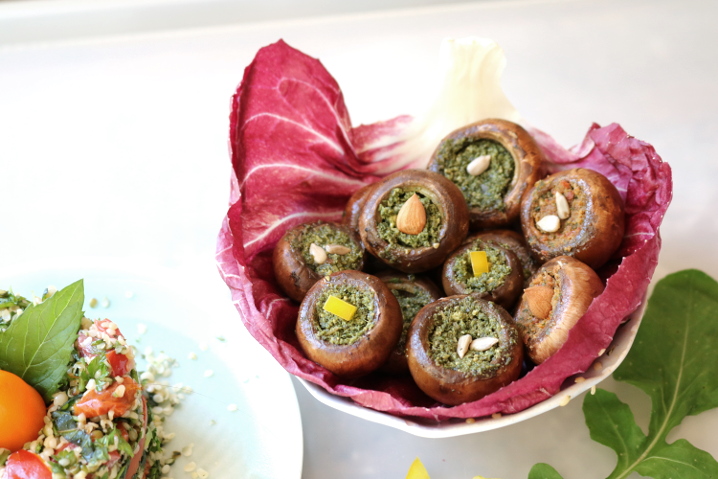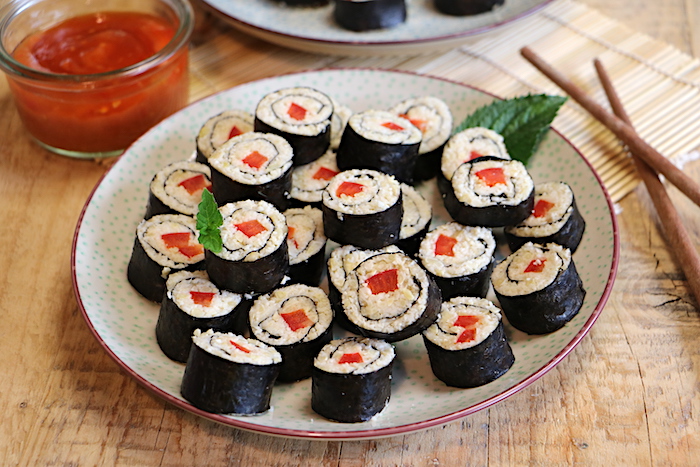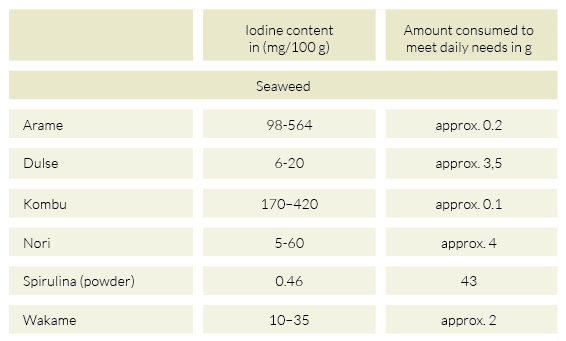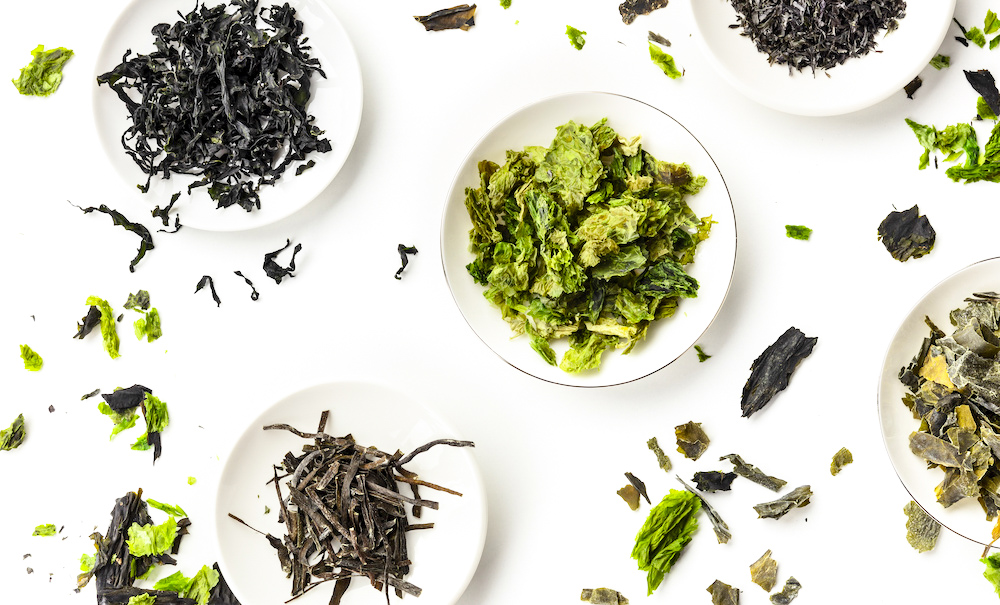An optimal supply of iodine is incredibly important to our health. If you know which foods are rich in iodine, you can get a good supply naturally through a vegan diet and find your ideal intake amount.
How Does Iodine Function in the Body?
Iodine is a trace element that’s important for every cell in the body. Since our body isn’t able to produce iodine itself, we have to take it with our food. In addition to its importance for the thyroid gland, this trace element has quite a few tasks.
Thyroid gland and energy metabolism
Iodine performs most of its tasks in connection with the thyroid gland. Here, iodine is needed for the production of the thyroid hormones thyroxine (T4) and triiodothyronine (T3). With these iodine-containing hormones, the small, butterfly-shaped gland controls a variety of bodily functions like energy metabolism, heartbeat, and blood pressure.
Nerves, brain, and cells
Iodine is also an essential aspect of brain function and a healthy nervous system. It’s involved in any growth processes like bone formation and every single cell division. That’s why getting enough iodine is especially important during pregnancy. Studies show that an iodine deficiency can lead to miscarriages and malformations, (1) and can have a negative influence on the child’s intelligence (2).
Immunological effect
In addition to its special organ-specific functions, iodine also has antiviral, antimicrobial, and antifungal effects, which is why, centuries ago, it was used as a disinfectant. Iodine also has an immunological effect inside the body, which means people who suffer from chronic infections could be deficient in iodine.
Antioxidant effect
The best known antioxidants are vitamin C, selenium, and glutathione. Less well known is the function of iodine as a free radical scavenger. As an antioxidant, iodine performs an important role in cell metabolism and protects cells from being destroyed by free radicals.
Protection against radioactive contamination
Iodine also protects the thyroid gland from radioactive exposure. In the case of a disaster, the government may prescribe the intake of iodine to prevent the thyroid gland from being infiltrated by radioactive iodine.
Detoxification of halogens and heavy metals
In the absence of iodine, i.e. in the case of an iodine deficiency, toxic halogens like bromine and fluorides, as well as heavy metals, can come in and take the iodine’s “place” in the body, like in the thyroid gland, for example. These halogens compete with iodine, so to speak, for resorption and being able to bind to receptors.
Conversely, iodine can displace them again. If you take iodine when poisoned, this causes an increased excretion of halogens or heavy metals. This explains why iodine ingestion can cause violent detoxification reactions like nausea, skin rashes, or a raised pulse. This type of reaction is often interpreted as iodine intolerance.
In order for iodine to fulfill its numerous tasks in the body, it requires some cofactors:
- Fatty acids (omega-3 and omega-6 fatty acids in the correct ratio of at least 5 : 1)
- Selenium
- Iron
- Vitamins A, C, and D
How Much Iodine Do We Need?
The Institute of Medicine has set the Recommended Dietary Allowance (RDA) for iodine intake in adult men and women 19+ years at 150 μg per day, and 220 and 290 mcg daily for pregnant and lactating women, respectively.
These amounts are intended specifically to cover the needs of the thyroid gland. The requirements of the other organs and glands like the liver, mammary glands, and ovaries are not taken into account here.
What’s interesting is that people in Japan consume more than 12 milligrams (12,000 μg) of iodine per day, or in other words, 60 times as much as the recommended amount, by consuming fish and seaweed. That being said, Japan is one of the countries with the lowest breast cancer rate.
What Happens in the Case of an Iodine Deficiency?
With a proper amount, the thyroid gland stores about 10 milligrams of iodine and can thus cover the body’s need for about 3 to 6 months. Small amounts of iodine are also stored in other organs, like the liver, so the body is able to compensate for a short-term iodine deficiency as long as it’s been previously well supplied.
Disturbed hormone production by the thyroid gland
If we’re exposed to an iodine deficiency over a longer period of time, this can lead to health problems, especially once the body’s own reserves have been used up: the thyroid gland is no longer able to produce the thyroid hormones T3 and T4 in the necessary amounts.
Hypothyroidism
In the long run, iodine deficiency can lead to enlargement of the thyroid gland, hypothyroidism, or Hashimoto’s thyroiditis. The thyroid gland regulates quite a few bodily systems, like energy metabolism, intestinal activity, mental state, and blood pressure. This means that thyroid malfunction can be shown by multiple symptoms.
If pregnant and breastfeeding women do not get enough iodine in their diets, the iodine deficiency can lead to miscarriages, malformations, bone maturation, and growth disorders (in the brain, for example).
One in three with abnormal thyroid findings
In 2002, the world’s largest ultrasound examination (Papillon study) was carried out in Germany on a total of 96,278 people between the ages of 18 and 65 who were considered to be healthy. This showed that one in three of those examined had abnormal thyroid findings in the ultrasound. Surveys of participants revealed that 96% of men and 97% of women were below the recommended iodine intake without using iodized table salt (5).
Other possible consequences of iodine deficiency
- Susceptibility to infections
- Infertility
- It’s argued that iodine deficiency is involved in the development of certain breast cancers.
- Iodine deficiency promotes the accumulation of other elements of the halogen family like chlorides, bromides, and fluorides, as well as heavy metals like mercury.
Check iodine status
Anyone who wants to check their individual iodine status can do this with a 24-hour iodine excretion test. This measures the excretion of iodine in the urine over the course of an entire day. Concentrations between 100-199 µg iodine/liter mean that the person’s iodine intake is ideal (WHO 2013).

Optimal Supply of Iodine in the Raw-Vegan Diet
Although the bioavailability of iodine is very high at up to 90%, the regional supply in many countries offers only limited opportunities to meet one’s iodine needs through plant foods, as a result of iodine-poor soils.
Animal foods and conventionally processed foods
The situation is quite different for people who eat animal foods and/or conventionally processed foods. Due to the iodization of processed foods with iodized table salt, the iodine content of a lot of types of food is already quite high. Animal foods can be very high in iodine because most livestock feed is iodized.
The iodine content of plant foods
The iodine values of plant foods (for example, apple 2 g, broccoli 12 g, sunflower seeds 4 g) show that it is not at all easy to meet the minimum requirement of 200 µg via plant foods.
Are you interessted in gaining a comprehensive understanding of the health benefits of a plant-based diet? Download the curriculum for our Holistic Nutrition Coach training program.
Goitrogens
Additionally, there are a number of factors that hinder iodine absorption, which are known as goitrogens.
These include:
- Goitrogenic foods (cabbage, cress, flaxseed). In the case of an iodine deficiency, these should only be consumed in small amounts.
- Perchlorate, bromide, and fluoride
- Cigarette smoke
- Estrogen dominance
Thank goodness for iodine-rich fish and iodized salt, right? Actually, we don’t think these are such a great solution.
Marine fish
Marine fish is considered a valuable food because of its high polyunsaturated fatty acid content and iodine content. But more and more environmental physicians and doctors are warning against regular fish consumption, pointing to high levels of heavy metals and other industrial toxins in marine animals.
Iodized table salt
Thanks to the iodization of table salt, this has accomplished an almost complete decrease in goiters and cretinism (dwarfism and mental development disorder). So iodized salt is an important source of iodine for people whose diets are otherwise low in iodine.
Our concerns about the consumption of iodized table salt
Iodized table salt is produced on the basis of refined salt. In this process, natural salt is refined to remove supposed impurities (and thus also minerals), recrystallized, dried, bleached, and, after being ground, enhanced with chemical substances. The resulting table salt ends up consisting of 99% sodium chloride. The remaining percent is a mixture of free-flowing agents (magnesium carbonate, aluminum oxide, etc.) and iodine in the form of synthetic potassium iodide.
In its isolated form, sodium chloride has many harmful effects on the human body. Its main effect is on the regulation of extra- and intracellular fluids, which can manifest itself in water retention or high blood pressure.
A great alternative is the use of natural salt like rock or crystal salt, enriched with algae. Natural salts consist of about 75% sodium chloride and also include a broad spectrum of a total of 84 minerals and trace elements.

Iodine Sufficiency with Algae
Algae can be divided into marine and freshwater algae. Marine algae are exceptionally rich in iodine. Depending on the variety, tiny amounts are enough to cover the daily iodine requirement. The freshwater algae Chlorella and Spirulina only contain small amounts of iodine.
The following overview shows the iodine content of various marine algae. The data are based on average values (data without guarantee).
Note: 200 micrograms (µg) correspond to 0.2 milligrams (mg).

The iodine content of seaweed can vary quite a bit from variety to variety, and depending on harvest time and place of growth, should be indicated on the package. If necessary, the iodine content can be reduced up to 90% through soaking and rinsing.
The daily recommended intake
The recommended daily iodine amount is 150 µg or 0.15 mg.
That being said, there are expert opinions that recommend a significantly higher iodine intake of up to 12 mg in connection with an optimal iodine sufficiency. According to current estimates, the thyroid gland requires approximately 30% of the body’s total iodine intake, with the remaining 70% distributed among the other organs. In order to benefit from iodine as a healing agent, it’s best to aim for a proper supply of iodine to all cells of the body.
Pay attention to quality
Certain harmful substances like heavy metals can accumulate in algae. So it’s important to be well informed about where and how they were grown. They should always be analyzed for certain pollutants and the iodine content should be indicated on the packaging.
Culinary temptation
In addition to being healthy, seaweed also has plenty of culinary benefits. Aside from sushi rolled in nori sheets, bladderwrack & co. also provide some interesting flavors. Algae leaves, spaghetti, or flakes activate our umami receptors and have a wide variety of tastes, from mild to slightly nutty, to spicy, and always a bit like the sea.
While seaweed is an important everyday food in Asia and especially in Japan, it’s gradually finding its way into gourmet kitchens in the West, as well as into uncomplicated everyday cooking. In the form of algae flakes, seaweed can be used as a salt substitute or flavor enhancer, and especially as a natural source of iodine in soups or sprinkled over salads.
Conclusion:
Considering that 150 μg/day is considered the optimum, but also that other countries consume 60 times that amount without experiencing problems with overdoses, 150 μg of iodine per day should be considered the lowest tolerable limit.
If you want to increase your iodine consumption, you should use natural iodine sources like algae, and slowly work your way up to a higher dose.
Personal experience as well as research show that iodine from natural sources is the best supply for the body. The danger of overdose seems to come more from synthetic iodine compounds.
Sources:
- David Brownstein, M.D. “Overcoming Thyroid Disorders”
- Farrow, Lyanne. The Iodine Crisis: What You Don‘t Know About Iodine
Can Wreck Your Life. (1.Edition) Devon Press 2013
Would you like to join our unique, based on nutritional sciences and practice-oriented training program for gaining a high level of health?
We are more than happy to inform you about our training program on our website!





0 Comments